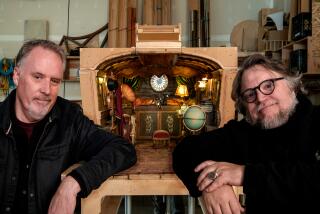A seasonal favorite is given added dimension
- Share via
JUST in time for Halloween and marking, appropriately enough, its 13th anniversary, Tim Burton’s “The Nightmare Before Christmas” has just been re-released by Walt Disney Pictures -- but this time in 3-D.
Though Disney re-released “Chicken Little” in 3-D last year, Burton’s stop-motion ode to all things creepy and crawly represents the first time the studio has converted an analog 2-D film into a completely digital 3-D film.
For the record:
12:00 a.m. Oct. 30, 2006 For The Record
Los Angeles Times Monday October 30, 2006 Home Edition Main News Part A Page 2 National Desk 1 inches; 46 words Type of Material: Correction
‘Nightmare Before Christmas’: A story in Thursday’s Calendar Weekend about the theatrical release of the 3-D version of “The Nightmare Before Christmas” misspelled the name of a Beverly Hills-based company that outfits theaters with digital 3-D equipment. The company’s name is Real D, not Read D.
“ ‘Nightmare’ is such a cult film, and the fact that it was created with puppets, which by their very nature exist in a three-dimensional world, made it the perfect movie to convert into 3-D,” says Don Hahn, who produced the film’s 3-D version. “When we did the first test nine months ago, we were blown away by the fact that you were almost living amongst the puppets in their world, and you could almost feel the textures and the fabric.”
To transform “Nightmare” into what Disney calls “Disney Digital 3D,” a digital version of the original film was required. For that, Hahn turned to Industrial Light & Magic, which also worked on the 3-D re-release of “Chicken Little,” and in just 19 months, ILM took the flat world of the original “Nightmare” and painstakingly created a digital copy, frame by frame.
“ILM makes it look easy, though it’s not, and they deserve all the credit for making it look so good,” Hahn says. “There are moments in the movie that are just awesome to me -- when Jack is in the sleigh riding over the rooftops and delivering presents, he’s literally flying above the audience.”
As it turns out, the illusion of depth is created by the left eye viewing images from the original “Nightmare” and the right eye viewing images from the new digital version.
In years past, those images were sent from tandem projection systems and were viewed through flimsy red and blue paper glasses that compromised color and often caused headaches.
Today, companies such as Beverly Hills-based Read D are outfitting theaters with state-of-the-art digital 3-D equipment that includes a single projector system that uses polarized light to alternately send images to each eye at a rate of 72 images per second (as a comparison, standard films are shown at a rate of 24 frames per second). And to make sure each image makes it to the correct eye, audience members don Ray-Ban-like glasses sporting image-sorting polarized lenses.
So far, after its first weekend, Jack and Sally’s move to the third dimension has scared up $3.3 million domestically in 168 theaters.
“Were obviously very happy with the numbers and we all agree that the movie worked well,” Hahn says. “More than anything, however, we wanted to stay true to Tim’s vision, so the biggest compliment came from Tim himself, who knocked us off our feet when he said that the 3-D version was an improvement on his movie.”
More to Read
Only good movies
Get the Indie Focus newsletter, Mark Olsen's weekly guide to the world of cinema.
You may occasionally receive promotional content from the Los Angeles Times.









